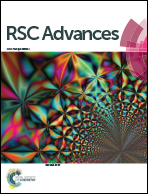Controllable synthesis of Bi2S3/CuS heterostructures by an in situ ion-exchange solvothermal process and their enhanced photocatalytic performance
Abstract
A novel Bi2S3/CuS hybrid photocatalyst with a 3D hierarchical configuration has been synthesized through an in situ solution-based cation exchange reaction that creates a heterojunction between a single-crystalline Bi2S3 nanotube/nanorod core and CuS nanoplates shell. The crystal structure, optical absorption and morphology evolutions of the nanocomposites with different Bi2S3 to CuS ratios were investigated systematically, and a possible formation process of the heterostructure was proposed. The Bi2S3/CuS hierarchical nanocomposite photocatalysts exhibit a broad range of absorption wavelength and good visible-light-driven photocatalytic activity for the degradation of rhodamine B (RhB) aqueous solution, compared with bare orthorhombic Bi2S3 nanotubes/nanorods. The enhanced photocatalytic performance of the Bi2S3/CuS composites could be attributed to the effective electron–hole separation at the interface of these two semiconductors, as well as wider and more intensified light absorption of the solar spectrum. The present study provides helpful insight into rational design and fabrication of novel and efficient chalcogenide-based heterostructure photocatalysts.


 Please wait while we load your content...
Please wait while we load your content...